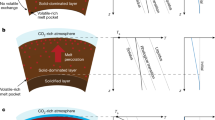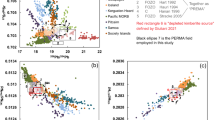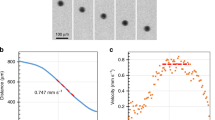Abstract
Seismological observations have identified large-scale compositional heterogeneities in the Earth’s deep mantle1,2,3,4,5. These heterogeneities may represent reservoirs of primitive material that differentiated early in Earth’s history6,7,8. The volcanic rocks that make up ocean islands are thought to be sourced, in part, from these deep reservoirs, with the primitive material transported to the surface via mantle plumes. Geochemical signatures within the erupted ocean island basalts further support the idea that the regions of heterogeneity are composed of primitive, undegassed mantle material7,9,10,11,12,13,14. Here we perform numerical experiments of thermo-chemical convection to simulate the entrainment of primitive material by plumes generated at the top of primitive reservoirs in the deep mantle. We vary the chemical density contrast between the primitive, undegassed and regular, degassed mantle materials. We find that the simulations that reproduce the observed geometry of the heterogeneous regions also explain the geochemical signatures measured in ocean island basalts. In these simulations, the entrainment of primitive material into the mantle plume does not exceed 9%. We conclude that the presence of primitive reservoirs in the deep mantle is dynamically feasible and satisfies both seismological and geochemical constraints.
This is a preview of subscription content, access via your institution
Access options
Subscribe to this journal
Receive 12 print issues and online access
$259.00 per year
only $21.58 per issue
Buy this article
- Purchase on Springer Link
- Instant access to full article PDF
Prices may be subject to local taxes which are calculated during checkout




Similar content being viewed by others
References
van der Hilst, R. D. & Kárason, H. Compositional heterogeneities in the bottom 1,000 km of Earth’s mantle: Towards a hybrid convection model. Science 283, 1885–1888 (1999).
Masters, G., Laske, G., Bolton, H. & Dziewonski, A. M. in Earth’s Deep Interior: Mineral Physics and Tomography from the Atomic to the Global Scale (eds Karato, S-I. et al.) 63–87 (Geophysical Monograph Ser., Vol. 117, American Geophysical Union, 2000).
Deschamps, F. & Trampert, J. Mantle tomography and its relation to temperature and composition. Phys. Earth Planet. Inter. 140, 277–291 (2003).
Ishii, M. & Tromp, J. Normal-mode and free-air gravity constraints on lateral variations in velocity and density of Earth’s mantle. Science 285, 1231–1236 (1999).
Trampert, J., Deschamps, F., Resovsky, J. S. & Yuen, D. A. Probabilistic tomography maps significant chemical heterogeneities in the lower mantle. Science 306, 853–856 (2004).
Solomatov, V. S. & Stevenson, D. J. Suspension in convective layers and style of differentiation of a terrestrial magma ocean. J. Geophys. Res. 98, 5375–5390 (1993).
Boyet, M. & Carlson, R. W. 142Nd evidence for early (>4.53 Ga) global differentiation of the silicate Earth. Science 309, 576–581 (2005).
Lee, C-T. et al. Upside-down differentiation and generation of a ‘primordial’ lower mantle. Nature 463, 930–933 (2010).
Allègre, C. J., Staudacher, T., Sarda, P. & Kurtz, M. Constraints on evolution of Earth’s mantle from gas rare systematic. Nature 303, 762–766 (1983).
Farley, K. A., Natland, J. H. & Craig, H. Binary mixing of enriched and undegassed (primitive?) mantle components (He, Sr, Nd, Pb) in Samoan lavas. Earth Planet. Sci. Lett. 111, 183–199 (1992).
Allègre, C. J., Hofmann, A. & O’Nions, K. The Argon constraints on mantle structure. Geophys. Res. Lett. 24, 3555–3557 (1996).
Hofmann, A. W. Mantle geochemistry: The message from oceanic volcanism. Nature 385, 219–229 (1997).
Stuart, F. M., Lass-Evans, S., Fitton, J. G. & Ellam, R. M. High 3He/4He ratios in picritic basalts from Baffin Island and the role of a mixed reservoir in mantle plumes. Nature 424, 57–59 (2003).
Jackson, M. G. et al. Evidence for the survival of the oldest terrestrial mantle reservoir. Nature 466, 853–856 (2010).
Allègre, C. J. & Moreira, M. Rare gas systematic and the origin of oceanic islands: The key role of entrainment at the 670 km boundary layer. Earth Planet. Sci. Lett. 228, 85–92 (2004).
van der Hilst, R. D., Widiyantoro, S. & Engdahl, E. R. Evidence for deep mantle circulation from seismic tomography. Nature 386, 578–584 (1997).
Davaille, A. Simultaneous generation of hotspots and superswells by convection in a heterogeneous planetary mantle. Nature 402, 756–760 (1999).
Le Bars, M. & Davaille, A. Whole layer convection in a homogeneous planetary mantle. J. Geophys. Res. 109, B03403 (2004).
Tackley, P. J. Strong heterogeneity caused by deep mantle layering. Geochem. Geophys. Geosyst. 3, 1024 (2002).
McNamara, A. K. & Zhong, S. Thermochemical structures within a spherical mantle. J. Geophys. Res. 109, B07402 (2004).
McNamara, A. K. & Zhong, S. Thermochemical structure beneath Africa and the Pacific ocean. Nature 437, 1136–1139 (2005).
Tan, E. & Gurnis, M. Metastable superplumes and mantle compressibility. Geophys. Res. Lett. 32, L20307 (2005).
Tan, E. & Gurnis, M. Compressible thermo-chemical convection and application to the lower mantle. J. Geophys. Res. 112, B06304 (2007).
Deschamps, F. & Tackley, P. J. Exploring the model space of thermo-chemical convection I—principles and influence of the rheological parameters. Phys. Earth Planet. Inter. 171, 357–373 (2008).
Deschamps, F. & Tackley, P. J. Exploring the model space of thermo-chemical convection II—influence of physical and compositional parameters. Phys. Earth Planet. Inter. 176, 1–18 (2009).
van Summeren, J. R. G., van den Berg, A. P. & van der Hilst, R. D. Upwellings from a deep mantle reservoir filtered at the 660 km phase transition in thermo-chemical convection models and implications for intra-plate volcanism. Phys. Earth Planet. Inter. 172, 210–224 (2009).
Labrosse, S. Hotspots, mantle plumes and core heat loss. Earth Planet. Sci. Lett. 199, 147–156 (2002).
Humayun, M., Qin, L. & Norman, N. D. Geochemical evidence for excess iron in the mantle beneath Hawaii. Science 306, 91–94 (2004).
Javoy, M. et al. The chemical composition of the Earth: Enstatite chondrite model. Earth Planet. Sci. Lett. 293, 259–268 (2010).
Acknowledgements
We are grateful to A. McNamara and A. van den Berg for their useful and constructive comments and reviews. All thermo-chemical models of convection were calculated on ETH super-cluster Brutus.
Author information
Authors and Affiliations
Contributions
All three authors equally contributed to the project.
Corresponding author
Ethics declarations
Competing interests
The authors declare no competing financial interests.
Supplementary information
Supplementary Information
Supplementary Information (PDF 1659 kb)
Rights and permissions
About this article
Cite this article
Deschamps, F., Kaminski, E. & Tackley, P. A deep mantle origin for the primitive signature of ocean island basalt. Nature Geosci 4, 879–882 (2011). https://doi.org/10.1038/ngeo1295
Received:
Accepted:
Published:
Issue Date:
DOI: https://doi.org/10.1038/ngeo1295
This article is cited by
-
Effects of depth- and composition-dependent thermal conductivity and the compositional viscosity ratio on the long-term evolution of large thermochemical piles of primordial material in the lower mantle of the Earth: Insights from 2-D numerical modeling
Science China Earth Sciences (2023)
-
The evolution of basal mantle structure in response to supercontinent aggregation and dispersal
Scientific Reports (2021)
-
Mantle plumes and their role in Earth processes
Nature Reviews Earth & Environment (2021)
-
A coupled core-mantle evolution: review and future prospects
Progress in Earth and Planetary Science (2020)
-
Primordial helium entrained by the hottest mantle plumes
Nature (2017)



